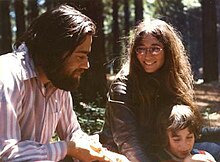Manuel Blum (born 26 April 1938) is a Venezuelan born American computer scientist who received the Turing Award in 1995 "In recognition of his contributions to the foundations of computational complexity theory and its application to cryptography and program checking".
Education
Blum was born to a Jewish family in Venezuela. Blum was educated at MIT, where he received his bachelor's degree and his master's degree in electrical engineering in 1959 and 1961 respectively. In MIT, he was recommended to Warren S. McCulloch, and they collaborated on some mathematical problems in neural networks. He obtained a Ph.D. in mathematics in 1964 supervised by Marvin Minsky.
Career
Blum worked as a professor of computer science at the University of California, Berkeley until 2001. From 2001 to 2018, he was the Bruce Nelson Professor of Computer Science at Carnegie Mellon University, where his wife, Lenore Blum, was also a professor of Computer Science.
In 2002, he was elected to the United States National Academy of Sciences. In 2006, he was elected a member of the National Academy of Engineering for contributions to abstract complexity theory, inductive inference, cryptographic protocols, and the theory and applications of program checkers.
In 2018 he and his wife Lenore resigned from Carnegie Mellon University to protest against sexism after a change in management structure of Project Olympus led to sexist treatment of her as director and the exclusion of other women from project activities.
Research
In the 60s he developed an axiomatic complexity theory which was independent of concrete machine models. The theory is based on Gödel numberings and the Blum axioms. Even though the theory is not based on any machine model it yields concrete results like the compression theorem, the gap theorem, the honesty theorem and the Blum speedup theorem.
Some of his other work includes a protocol for flipping a coin over a telephone, median of medians (a linear time selection algorithm), the Blum Blum Shub pseudorandom number generator, the Blum–Goldwasser cryptosystem, and more recently CAPTCHAs.
Blum is also known as the advisor of many prominent researchers. Among his Ph.D. students are Leonard Adleman, Dana Angluin, Shafi Goldwasser, Mor Harchol-Balter, Russell Impagliazzo, Silvio Micali, Gary Miller, Moni Naor, Steven Rudich, Michael Sipser, Ronitt Rubinfeld, Umesh Vazirani, Vijay Vazirani, Luis von Ahn, and Ryan Williams.
See also
- List of Venezuelans
- Graph isomorphism problem
- Non-interactive zero-knowledge proof
- Quantum coin flipping
- Pancake sorting
References
- ^ Manuel Blum at the Mathematics Genealogy Project.
- ACM Turing Award Citation, retrieved 2010-01-24.
- Manuel Blum at DBLP Bibliography Server

- Manuel Blum publications indexed by Microsoft Academic
- Blum, Manuel; Micali, Silvio (1984). "How to Generate Cryptographically Strong Sequences of Pseudorandom Bits" (PDF). SIAM Journal on Computing. 13 (4): 850. doi:10.1137/0213053. S2CID 7008910.
- Blum, M.; Floyd, R. W.; Pratt, V. R.; Rivest, R. L.; Tarjan, R. E. (August 1973). "Time bounds for selection" (PDF). Journal of Computer and System Sciences. 7 (4): 448–461. doi:10.1016/S0022-0000(73)80033-9.
- ^ Blum, Manuel (1967). "A Machine-Independent Theory of the Complexity of Recursive Functions" (PDF). Journal of the ACM. 14 (2): 322–336. doi:10.1145/321386.321395. S2CID 15710280.
- Blum, L.; Blum, M.; Shub, M. (1986). "A Simple Unpredictable Pseudo-Random Number Generator". SIAM Journal on Computing. 15 (2): 364. doi:10.1137/0215025.
- "Lenore Blum biography". www-groups.dcs.st-and.ac.uk. Retrieved 16 February 2019.
- Blum, Manuel. "Properties of a neuron with many inputs." Bionics Symposium: Living Prototypes--the Key to New Technology, 13-14-15 September 1960. WADD technical report, 60-600. (1961)
- McCulloch, Warren (1961). "What is a number, that a man may know it, and a man, that he may know a Number" (PDF). General Semantics Bulletin (26 & 27): 7–18.
- "How this Turing Award–winning researcher became a legendary academic advisor". MIT Technology Review. Retrieved 12 October 2024.
- Blum, L.; Blum, M. (1975). "Toward a mathematical theory of inductive inference". Information and Control. 28 (2): 125. doi:10.1016/S0019-9958(75)90261-2.
- "Lenore Blum shocked the community with her sudden resignation from CMU. Here she tells us why". 6 September 2018.
- Von Ahn, Luis; Blum, Manuel; Hopper, Nicholas J.; Langford, John (May 2003). "CAPTCHA: Using Hard AI Problems for Security". Proceedings of the International Conference on the Theory and Applications of Cryptographic Techniques (EUROCRYPT 2003).
- American computer scientists
- Theoretical computer scientists
- 1938 births
- Living people
- Jewish American scientists
- International Association for Cryptologic Research fellows
- Members of the United States National Academy of Engineering
- Members of the United States National Academy of Sciences
- Turing Award laureates
- Carnegie Mellon University faculty
- UC Berkeley College of Engineering faculty
- Venezuelan emigrants to the United States
- Venezuelan Jews
- Massachusetts Institute of Technology School of Science alumni
- 20th-century American engineers
- 21st-century American engineers
- 20th-century American scientists
- 21st-century American scientists
- MIT School of Engineering alumni
- People from Caracas
